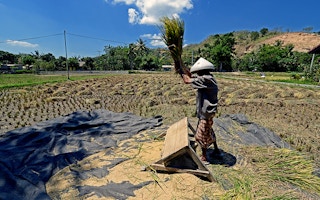The planet’s daily bread could be at risk as the global thermometer creeps up and climates begin to change. New research has warned that almost two thirds of the world’s wheat-growing areas could face “severe, prolonged, and near-simultaneous droughts” by the century’s end.
Right now, 15 per cent of the world’s wheat producing regions are at risk of severe water scarcity at the same time. Even if the 195 nations that agreed in Paris to stop global average temperatures from rising beyond 1.5°C by 2100 keep that promise, the chance of simultaneous water stress across continents would still double between 2030 and 2070.
But if nations fail to mitigate the climate change and extremes of heat and rainfall that would inevitably follow runaway global heating, then the chances of devastating failure of wheat harvests in both Europe and North America, or both Europe and Australia, or Russia, Ukraine and Kazakhstan, begin to soar.
Wheat provides one-fifth of all the calories for humankind. It is the world’s largest rain-fed crop and the global wheat trade matches the traffic in rice and in maize combined. Ten regions account for 54 per cent of the planet’s wheat fields, and 57 per cent of the world’s wheat.
Scientists from Europe, the US and China report in the journal Science Advances that they worked with computer simulations to model the future global weather for water scarcity with changes in temperature for the next eight decades.
Wheat is a successful crop partly because its water needs are relatively low, but it can’t flourish without reliable rainfall before and during growth. And the new simulations confirm earlier fears: that extremes of heat and devastating drought could happen in more than one continent at the same time.
When this happened in the 19th century, global famine followed. Forecasts already warn that with each 1°C rise in temperature, global wheat yield will fall by between 4 per cent and 6.5 per cent. Researchers have repeatedly warned that extremes of heat can slash yields and limit the vital nutrients in cereal harvests. Other teams have found that climate change may already be making this happen.
Worse could follow as one heat wave is pursued promptly by another. And all this could happen in a world in which, as population grows, demand for wheat could increase by at least 43 per cent.
Continued checking
Scientists tend not to take the research of others for granted: they keep on checking. The latest simulation analysed 27 different climate models, each with three different scenarios.
The scientists looked at evidence from the near-past to find that between 1985 and 2007, the impact of drought on world wheat production was twice that between 1964 and 1984.
They included developing countries and low-income nations in eastern and southern Asia in their survey, because these are where half of the already hungry and under-nourished live, and where bread is an important part of people’s diet.
“The results indicate a severely heightened risk of high-impact extreme events under the future climate, which would likely affect all market players, ranging from direct influences on subsistence farmers to price-mediated changes in international markets”, they write.
This story was published with permission from Climate News Network.

















